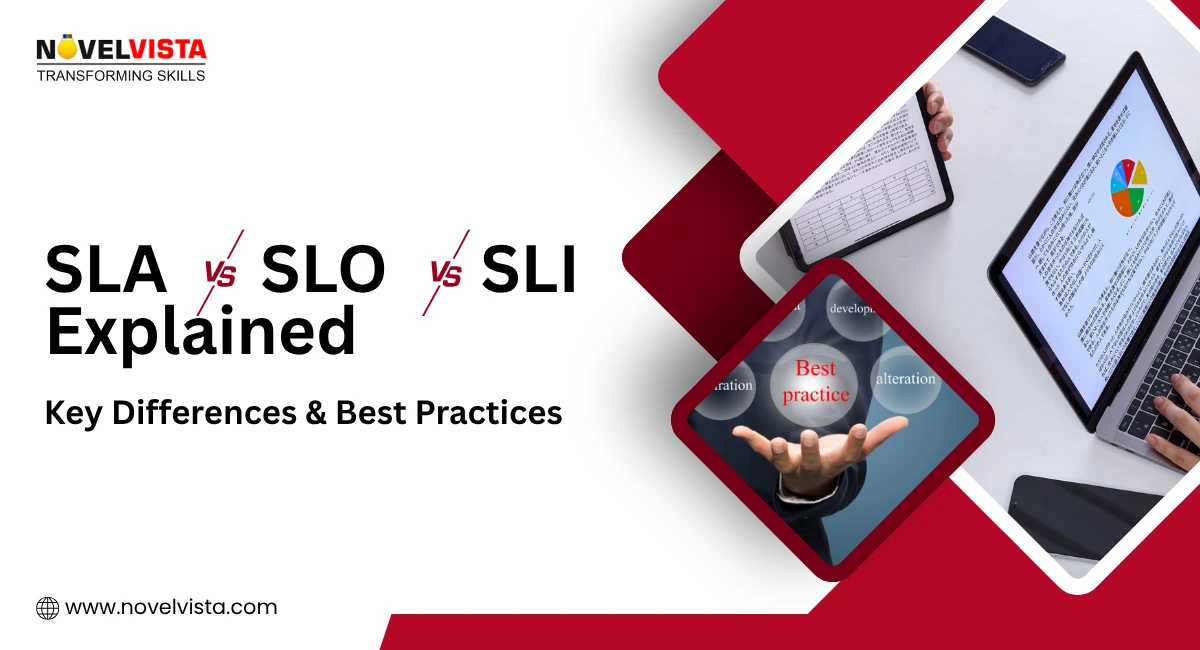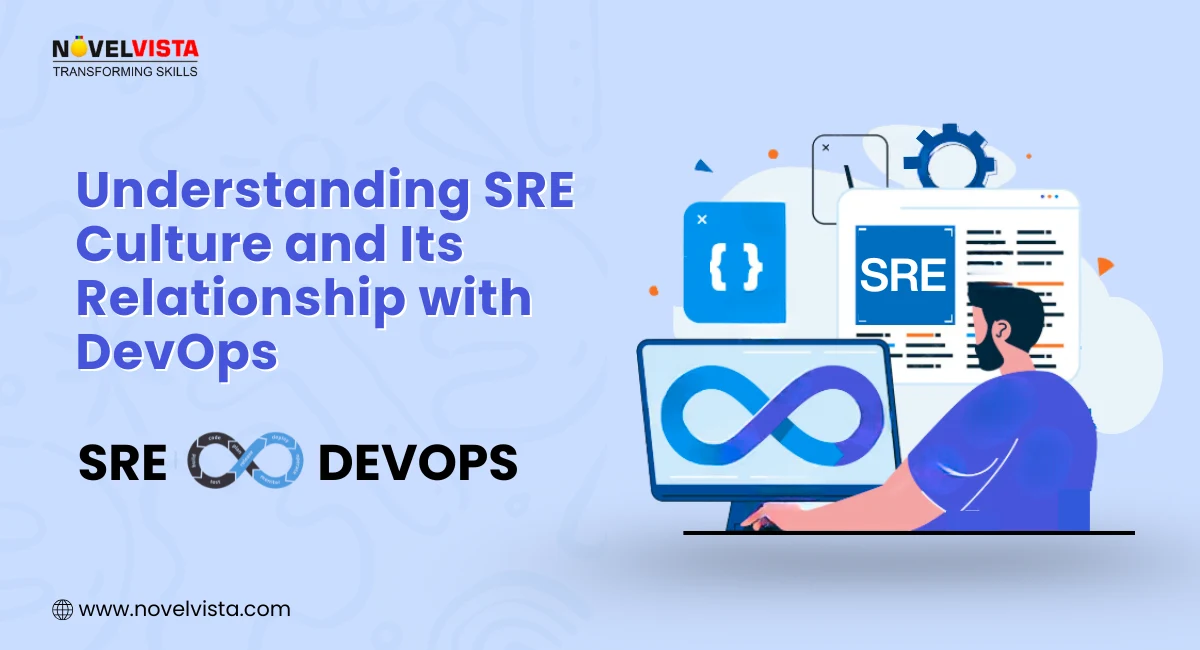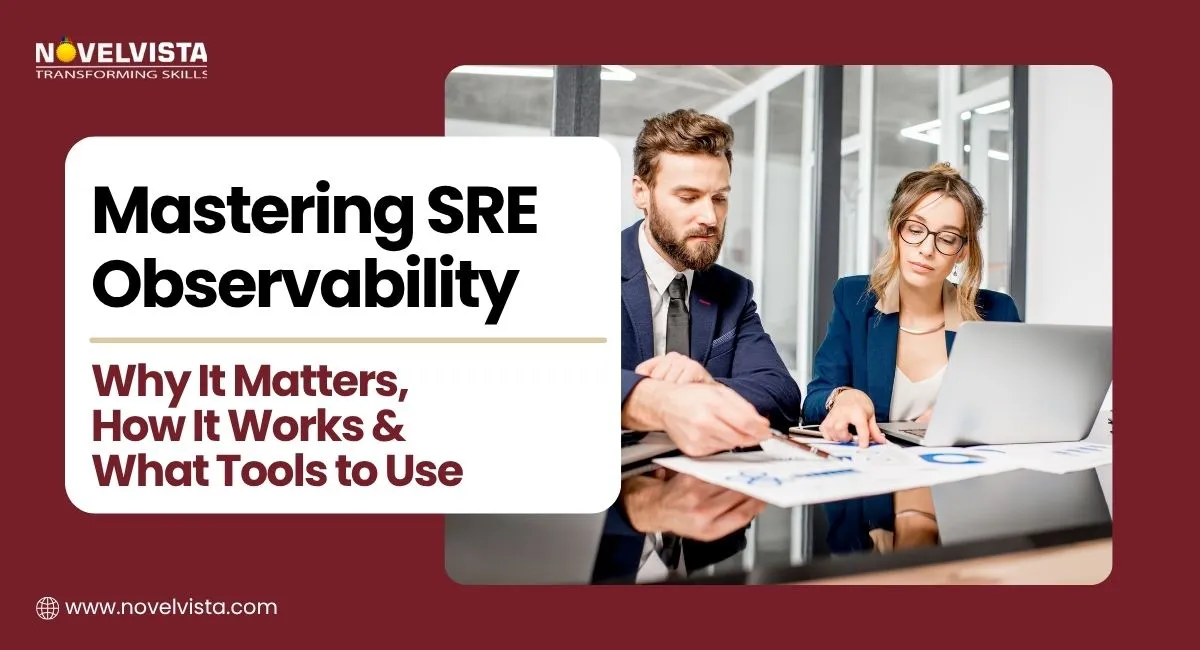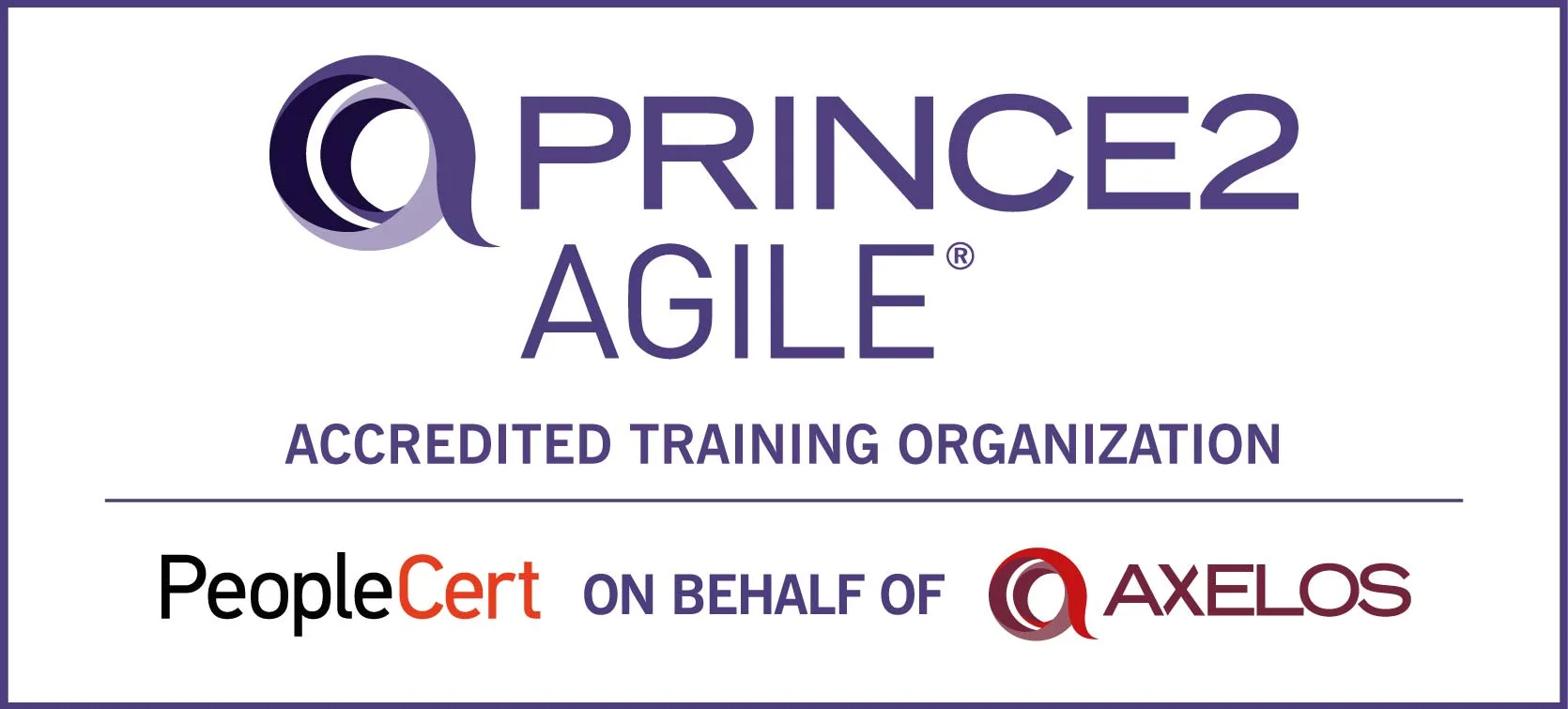- What is an SLI (Service Level Indicator)?
- What is an SLO (Service Level Objective)?
- What is an SLA (Service Level Agreement)?
- SLI vs SLO vs SLA
- Understanding Error Budgets
- How SLIs, SLOs, SLAs, and Error Budgets Work Together
- Best Practices for Implementing SLIs, SLOs, SLAs, and Error Budgets
- Common Mistakes and How to Avoid Them
- Practical Examples
- Conclusion
Understanding SLA vs SLO vs SLI is often confusing, yet these are the backbone of modern Site Reliability Engineering (SRE). Simply put: SLIs measure performance, SLOs set the target, and SLAs formalize commitments to customers. Error budgets act as a safety buffer, letting teams innovate while controlling risk.
For example, a streaming platform may track video start-up time (SLI), aim to have 99.9% of streams start within 2 seconds (SLO), guarantee this uptime in a contract (SLA), and use the allowable downtime as an error budget for testing new features. This framework keeps services reliable, customer expectations clear, and engineering decisions grounded in data. This article will go through the difference between SLI vs SLO vs SLA, what is error budget is, how these 4 work together, and the best practices for the same. Let’s dive in!
What is an SLI (Service Level Indicator)?
A Service Level Indicator (SLI) is a measurable metric that reflects the health of a service. Unlike vague phrases like “the system is fast,” SLIs provide concrete, quantitative insights.
Some common SLIs include:
- Availability: The percentage of time a service is accessible. For instance, if a cloud storage service is down for 2 hours in a month, your availability SLI can be calculated as 99.72%.
- Error Rate: Measures how often requests fail. A high error rate could indicate backend issues or network instability.
- Latency: Measures response times. For example, how quickly a webpage loads or an API responds.
- Throughput: Tracks the number of requests processed in a given period.
SLIs allow teams to identify trends, detect issues early, and make data-driven decisions. Think of SLIs like a car’s dashboard: speedometer, fuel gauge, and engine light show you what’s happening in real time.
SRE Common Mistakes & Fixes Cheat Sheet
- Avoid the traps that slow SRE teams down.
- Learn quick fixes to boost reliability,
- speed, and team confidence.
What is an SLO (Service Level Objective)?
A Service Level Objective (SLO) is the target set for an SLI over a defined period. It answers the question: “How good is good enough?”
Example: If your SLI measures latency, your SLO might state: “Average latency below 200ms for 95% of requests this month.”
SLOs are crucial because they provide internal benchmarks for reliability. If your SLO is met consistently, the system is performing well. If not, it signals the need for improvements.
Analogy: Think of SLOs as health targets, like maintaining a heart rate under 70 bpm during rest. The measurement (SLI) tells you your current state, and the target (SLO) guides behavior and decisions.What is an SLA (Service Level Agreement)?
A Service Level Agreement (SLA) formalizes performance commitments with customers. It usually references the SLOs but adds accountability and sometimes penalties.
Example: A SaaS provider guarantees 99.9% uptime. If the provider fails, the SLA may require compensation, such as service credits.
SLAs ensure customers know what to expect and protect both parties legally. Internally, teams may focus on SLOs to stay on track, but the SLA defines the customer-facing promise.
Think of an SLA like a rental contract: it sets clear expectations for both landlord and tenant.
SLI vs SLO vs SLA
Component |
SLI |
SLO |
SLA |
Definition |
A metric that shows service performance. |
A target set for an SLI |
A contract with customers |
Purpose |
Measures service performance |
Sets the performance goal for SLIs |
Formal commitment to customers |
Focus |
Focus on service health |
Focus on the performance target |
Focus on customer commitment |
Examples |
Latency, error rate, throughput |
99.9% uptime, <200ms latency |
Uptime guarantees, support response time |
Audience |
Teams / Engineers |
Teams / Engineers |
Customers |
Measurement |
Real-time |
Monthly/Quarterly |
Monthly/Quarterly |
Legally Actionable |
No, it’s not legally actionable |
No, it’s not legally actionable |
Yes, it’s legally actionable |
Flexibility |
High – It can track many metrics. |
Medium – It can be adjusted for each service or time period. |
Low – Because of legal binding |
When to Use |
Use to monitor the system continuously. |
Use to guide internal reliability goals. |
Use for customer agreements and guarantees. |
Error Budget Relevance |
Provides data to set SLOs |
Defines allowed failure (error budget) |
Penalties apply if breached |
This table summarizes differences sla vs slo vs sli, but each concept plays a specific role in SRE. SLIs provide data, SLOs define goals, SLAs formalize commitments, and error budgets guide innovation without compromising reliability.
Understanding Error Budgets
An error budget is the allowed level of service failure over a period. It lets teams balance reliability with the need to deploy new features.
For instance, if an SLO allows 0.1% downtime per month, that’s roughly 43 minutes of allowable failure. Teams can spend this budget on planned changes, A/B testing, or experiments.
Error budgets also improve collaboration: development teams can push updates without risking SLA violations, and operations teams know when to focus on stabilizing services. This creates a culture of measured risk-taking, where innovation and reliability coexist.
Error budgets are widely adopted in top tech organizations, including Google’s SRE teams, to balance innovation with service reliability. Applying error budgets effectively helps teams prioritize feature releases without risking SLA violations, following principles outlined in industry-standard SRE frameworks.
How SLIs, SLOs, SLAs, and Error Budgets Work Together
These four concepts are not isolated; they form a workflow that ensures reliable service delivery while allowing innovation. Here’s how they connect:
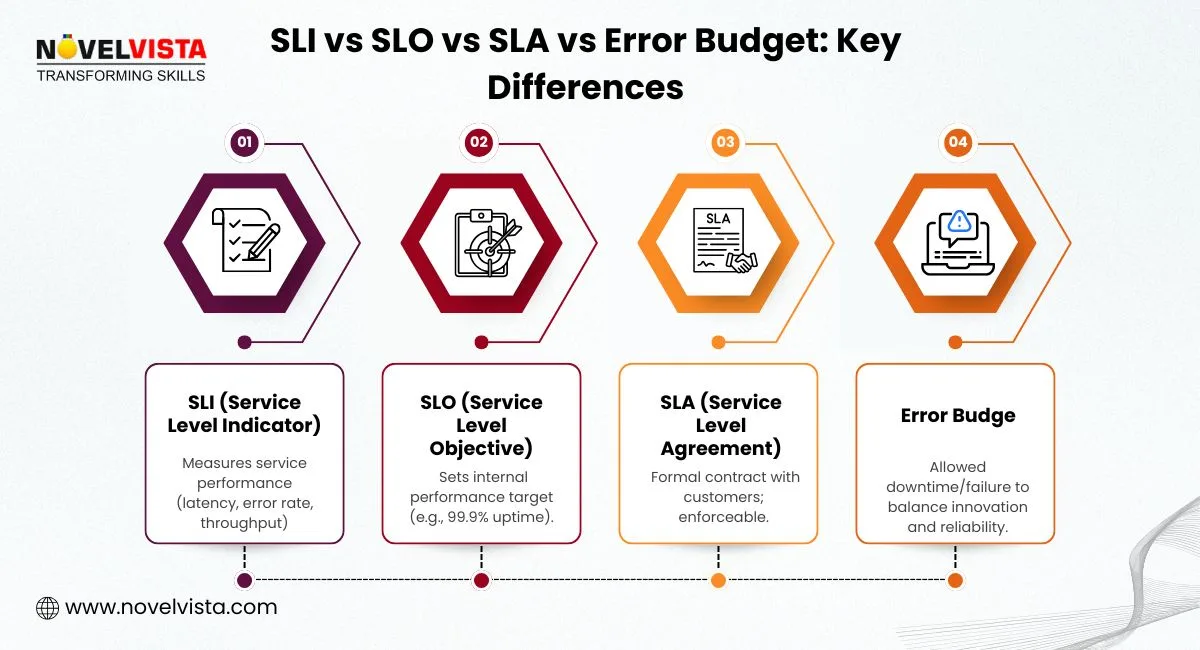
- Define SLIs: Start by identifying the most meaningful metrics that reflect user experience and service health. For example, a messaging app may track message delivery time and error rate.
- Set SLOs: Use SLIs to define clear performance targets. If the delivery time SLI is measured in milliseconds, the SLO could be “95% of messages delivered within 200ms.”
- Commit to SLAs: Translate internal SLOs into customer-facing commitments. This makes expectations transparent and enforceable. A company might promise 99.9% uptime in its SLA based on the SLO.
- Allocate Error Budgets: Error budgets are calculated from SLOs and define how much failure is acceptable without violating the SLA. Teams can then prioritize feature releases, maintenance, or experiments while staying within the budget.
Practical Workflow Example:
A cloud storage provider has:
- SLI: File download success rate
- SLO: 99.95% success monthly
- SLA: Guarantees 99.9% uptime to customers
- Error Budget: 0.05% failure allowed monthly
If new updates increase downtime slightly, the error budget guides whether it’s acceptable or if mitigation is needed. This ensures both reliability and innovation.
Related: Organizational Impact of SRE
Best Practices for Implementing SLIs, SLOs, SLAs, and Error Budgets
To get the most value from these metrics, follow these practical tips:
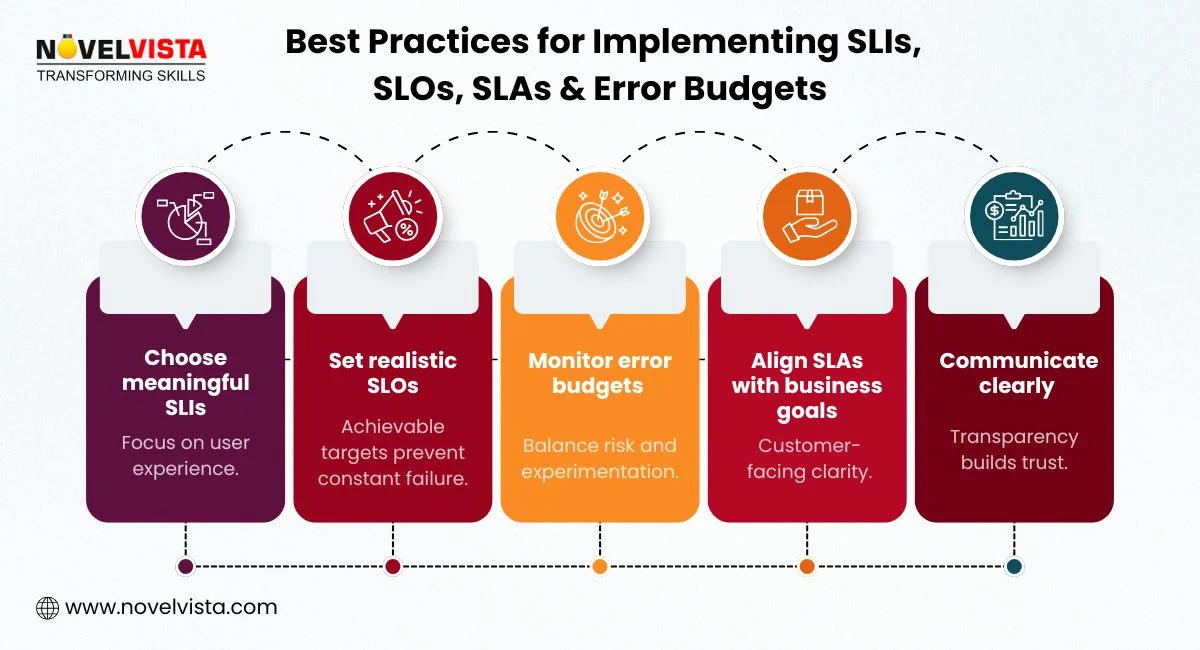
- Choose meaningful SLIs: Focus on what users care about, latency, error rate, and availability, rather than internal metrics that don’t reflect real experience.
- Set realistic SLO targets: Avoid overly aggressive targets that are impossible to meet, which could create stress and unnecessary firefighting.
- Monitor and adjust error budgets: Regularly review budget usage to balance risk and innovation. Overspending could jeopardize SLAs, while underspending may limit experimentation.
- Align SLAs with business goals: Make sure customer-facing agreements reflect both technical feasibility and user expectations.
- Communicate clearly: Teams, stakeholders, and customers should understand the SLIs, SLOs, and error budget policies. Transparency builds trust and prevents surprises.
Common Mistakes and How to Avoid Them
Even experienced teams can fall into pitfalls. Here’s how to avoid them:
- Tracking too many SLIs: Focus on a few critical metrics to avoid noise. Too many indicators dilute attention.
- Setting unrealistic SLOs: Targets that are too strict can lead to constant failure and demotivate teams.
- Ignoring error budgets: Neglecting budgets leads to uncontrolled risk and potential SLA breaches.
- Neglecting communication: Lack of transparency with stakeholders can result in misunderstandings or disputes about service quality.
By learning from these mistakes, teams can implement SRE metrics effectively, improving both reliability and innovation.
Also Read: SRE Roles and Responsibilities
Practical Examples
- E-commerce Platform: Tracks page load time (SLI), aims for 99.5% of pages loading under 2 seconds (SLO), guarantees 99% uptime to customers (SLA), and allows 0.5% downtime for testing (error budget).
- Video Streaming Service: Measures buffering events per stream (SLI), SLO is fewer than 2 buffering events per 1000 views, SLA guarantees 99.9% availability, error budget guides feature rollout like new codec deployment.
The examples provided are based on observed patterns in real-world SRE implementations across e-commerce and streaming platforms. While specific numbers may vary by organization, these scenarios illustrate typical approaches to aligning SLIs, SLOs, SLAs, and error budgets.
Conclusion
Understanding SLA vs SLO vs SLI and how error budgets work together is crucial for modern Site Reliability Engineering. These concepts ensure reliable service delivery, align engineering goals with business needs, and create a safe space for innovation. By measuring the right things, setting achievable targets, and clearly communicating commitments, teams can prevent downtime, improve customer trust, and maintain operational efficiency.
Next Step
Master the fundamentals of Site Reliability Engineering with NovelVista’s SRE Foundation Training. Learn how to define SLIs, set realistic SLOs, manage SLAs, and utilize error budgets to ensure reliable, high-performing systems. Gain hands-on knowledge to implement SRE practices in real-world projects and advance your career in modern IT operations. Enroll today and become a certified SRE professional.
Frequently Asked Questions
Author Details

Vaibhav Umarvaishya
Cloud Engineer | Solution Architect
As a Cloud Engineer and AWS Solutions Architect Associate at NovelVista, I specialized in designing and deploying scalable and fault-tolerant systems on AWS. My responsibilities included selecting suitable AWS services based on specific requirements, managing AWS costs, and implementing best practices for security. I also played a pivotal role in migrating complex applications to AWS and advising on architectural decisions to optimize cloud deployments.
Confused About Certification?
Get Free Consultation Call

